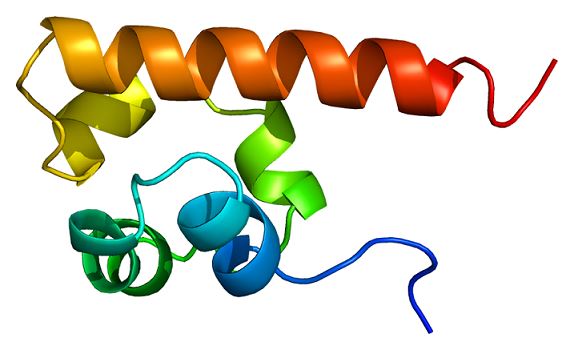EPHA4 belongs to the Tyr protein kinase family which is the largest known family of receptor tyrosine kinases, they are divided into A and B classes along with their ligands according to homology and binding affinities. EPHA4 is encoded by the EPHA4 gene which is located at 2q36.3. The expression of EPHA4 is ubiquitous in human. The molecular mass of it is about 109 KDa. Once binding of the ligand, it will form a heterotetramer which contains an ephrin dimer and a receptor dimer.
| Basic Information of EPHA4 | |
| Protein Name | Ephrin type-A receptor 4 |
| Gene Name | EPHA4 |
| Aliases | EPH-like kinase 8, EK8, hEK8, Tyrosine-protein kinase TYRO1, Tyrosine-protein kinase receptor SEK |
| Organism | Homo sapiens (Human) |
| UniProt ID | P54764 |
| TransmEPHA4rane Times | Single-pass membrane |
| Length (aa) | 986 |
| Sequence | MAGIFYFALFSCLFGICDAVTGSRVYPANEVTLLDSRSVQGELGWIASPLEGGWEEVSIMDEKNTPIRTYQVCNVMEPSQNNWLRTDWITREGAQRVYIEIKFTLRDCNSLPGVMGTCKETFNLYYYESDNDKERFIRENQFVKIDTIAADESFTQVDIGDRIMKLNTEIRDVGPLSKKGFYLAFQDVGACIALVSVRVFYKKCPLTVRNLAQFPDTITGADTSSLVEVRGSCVNNSEEKDVPKMYCGADGEWLVPIGNCLCNAGHEERSGECQACKIGYYKALSTDATCAKCPPHSYSVWEGATSCTCDRGFFRADNDAASMPCTRPPSAPLNLISNVNETSVNLEWSSPQNTGGRQDISYNVVCKKCGAGDPSKCRPCGSGVHYTPQQNGLKTTKVSITDLLAHTNYTFEIWAVNGVSKYNPNPDQSVSVTVTTNQAAPSSIALVQAKEVTRYSVALAWLEPDRPNGVILEYEVKYYEKDQNERSYRIVRTAARNTDIKGLNPLTSYVFHVRARTAAGYGDFSEPLEVTTNTVPSRIIGDGANSTVLLVSVSGSVVLVVILIAAFVISRRRSKYSKAKQEADEEKHLNQGVRTYVDPFTYEDPNQAVREFAKEIDASCIKIEKVIGVGEFGEVCSGRLKVPGKREICVAIKTLKAGYTDKQRRDFLSEASIMGQFDHPNIIHLEGVVTKCKPVMIITEYMENGSLDAFLRKNDGRFTVIQLVGMLRGIGSGMKYLSDMSYVHRDLAARNILVNSNLVCKVSDFGMSRVLEDDPEAAYTTRGGKIPIRWTAPEAIAYRKFTSASDVWSYGIVMWEVMSYGERPYWDMSNQDVIKAIEEGYRLPPPMDCPIALHQLMLDCWQKERSDRPKFGQIVNMLDKLIRNPNSLKRTGTESSRPNTALLDPSSPEFSAVVSVGDWLQAIKMDRYKDNFTAAGYTTLEAVVHVNQEDLARIGITAITHQNKILSSVQAMRTQMQQMHGRMVPV |
EPHA4 is a single-pass type I membrane protein spanning the membrane once, with its N-terminus on the extracellular side of the membrane and removal of its signal sequence. Functionally, it is a receptor tyrosine kinase which binds membrane-bound ephrin family ligands residing on adjacent cells, leading to contact-dependent bidirectional signaling into neighboring cells. EPHA4 also participates in lots of biological processes, such as adult walking behavior, glial cell migration, nephric duct morphogenesis as well as positive regulation of JUN kinase activity and so on. Accordingly, complex EphA4 signaling involving both homotypic and heterotypic cell-cell interactions. What’ s more, kinase-dependent EphA4 signaling is necessary for the adult SVZ/RMS neurogenic niche and unique organization of the postnatal and this strict organization support efficient neuroblast migration. EphA4 is a potential therapeutic target in ALS because of the low expression of EphA4 attenuates disease severity, and it can be approached using both small compounds and peptidergic antagonists.
 Fig .1 Structure of EPHA4 membrane protein
Fig .1 Structure of EPHA4 membrane protein
This article shows a soluble fusion protein, where the EphA4 ectodomain is fused to IgG Fc (EphA4 Fc). It is an effective therapy in acute injuries. However, its half-life efficiency limited its function. So, the authors design a special glycoengineering method to enhance the half-life of EphA4 Fc.
This article reveals that EphA4 has effects distinct from those of its close relative, EphA7, in the developing brain. Authors also suggest a novel molecular mechanism involving EphA4 signaling that functions in stem cell niche organization and ultimately neuroblast migration in the anterior forebrain.
This article suggests a novel molecular mechanism involving EphA4 signaling that functions in ultimately neuroblast migration in the anterior forebrain and stem cell niche organization. It also reveals that complex EphA4 signaling involving both homotypic and heterotypic cell-cell interactions.
This article finds that Ephrin-B3 is highly expressed in human biopsies and it inhibits EphA4 pro-apoptotic activity in tumor cells. Interference with EphA4/Ephrin-B3 interaction could then be envisaged as a relevant strategy to slow glioblastoma multiform growth by enhancing EphA4-induced cell death.
This article suggests that SORLA can interact with the EphA4 receptor tyrosine kinase and attenuate ephrinA1 ligand-induced EphA4 clustering and activation which is able to limit downstream effects of EphA4 signaling in neurons. It reveals a novel role for SORLA as a physiological and pathological EphA4 modulator.
To obtain the soluble and functional target protein, the versatile Magic™ membrane protein production platform in Creative Biolabs enables many flexible options, from which you can always find a better match for your particular project. Aided by our versatile Magic™ anti-membrane protein antibody discovery platform, we also provide customized anti-EPHA4 antibody development services.
As a forward-looking research institute as well as a leading custom service provider in the field of membrane protein, Creative Biolabs has won a good reputation among our worldwide customers for successfully accomplishing numerous challenging projects including generation of many functional membrane proteins. Please feel free to contact us for more information.
All listed services and products are For Research Use Only. Do Not use in any diagnostic or therapeutic applications.